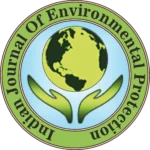IJEP 45(3): 276-282 : Vol. 45 Issue. 3 (March 2025)
A. Kavi Praba*, T.S. Raghav, M. J. Aravind Balaji and P. Yabes
Sathyabama Institute of Science and Technology, Department of Biotechnology, Chennai – 600 119, Tamil Nadu, India
Abstract
This project aims to reuse wastewater from toilet cleaners and soap to transform it into reclaimed water. The process involves mixing two types of wastewater, resulting in unfiltered water with insoluble precipitates that are separated by an economical water filter. The wastewater generated during bathing using soap is known as soap wastewater (SWW) and the wastewater generated during cleaning the toilet bowl using a toilet cleaner is referred to as toilet cleaner wastewater (TCWW). These two wastewaters are mixed in a precipitation tank where three main processes occur: neutralization, demulsification and precipitation of surfactants. This mixing process causes the contaminants in both wastewaters to precipitate, eliminating the need for extensive secondary treatments. Similarly, the mixture of RO membrane wastewater (ROWW) and SWW results in precipitation due to a process known as salting out. The wastewater mixture in the precipitation tank is then sent to an economical water filter made from waste materials, such as waste glass and ceramic tile waste. This concept of preparing reclaimed water can be implemented in residential apartments, individual houses and hotels. The end goal of this project is to produce water that can be reused in non-consumable ways, contributing to water conservation efforts. This project underscores the importance of innovative approaches to waste management and environmental sustainability.
Keywords
Reverse osmosis, Wastewaster treatment, Waste filter, Reclaimed water, Cost-friendly, Conservation
References
- Sultana, R., et al. 2022. Measuring water quantity used for personal and domestic hygiene and determinants of water use in a low-income urban community. Int. j. env. res. public health. 19(23): 15656. DOI: 10.3390/ijerph192315656.
- Othman, M.S.S. 2014. Investigating flush system method for minimum water usage of toilet system. Doctoral dissertation, Universiti Tun Hussein, Malaysia.
- Yoon, Y. and R. M. Lueptow. 2005. Removal of organic contaminants by RO and NF membranes. J. Membrane Sci., 261(1-2): 76-86. DOI: 10.1016/j.memsci.2005.03.038.
- Sarkic, A. and I. Stappen. 2018. Essential oils and their single compounds in cosmetics- A critical review. Cosmetics. 5(1): 11. DOI: 10.3390/cosmetics5010011.
- Xia, S., J. Guo and R. Wang. 2008. Performance of a pilot-scale submerged membrane bioreactor (MBR) in treating bathing wastewater. Bioresour. Tech., 99(15): 6834-6843. DOI: 10.1016/j.biortech.2008. 01.044.
- Itsadanont, S., et al. 2014. Dissolution of soap scum by surfactant. Part I: Effects of chelant and type of soap scum. J. Surfactants Detergents. 17 (5): 849-857. DOI: 10.1007/s11743-013-1544-3.
- Kulkarni, D. and D. Jaspal. 2023. Surfactants in wastewater: Development, current status and associated challenges. Mater. Today Proceedings. DOI: 10.1016/j.matpr.2023.11.022.
- Derickson, R., B. Seelig and F. Bergsrud. 1992. Treatment systems for household water supplies: Activated carbon filtration. J. Env. Sci. Tech., 87: 48-58.
- Kumar, R. 2023. Study of wastewater management and reuse among RO users: With special reference to Sharadha Nagar, Lucknow, India. Asian J. Adv. Res. Reports. 17(11): 203-213. DOI: 10.9734/ajarr/2023/v17i11567.
- Jamil, T. 2024. Application of ball clay/MnO2based catalytic ozonation process for textile wastewater treatment. Desalination Water Treatment. 318: 100394. DOI: 10.1016/j.dwt.2024.100394.
- Rutledge, S. O., C. Fahie and G.A. Gagnon. 2002. Assessment of crushed-recycled glass as filter media for drinking water treatment. Joint 2002 CSCE/ASCE International Conference on Environmental engineering – An international perspective on environmental engineering. Ontario, Canada. Proceedings, pp 477-482.
- Cescon, A. and J.Q. Jiang. 2020. Filtration process and alternative filter media material in water treatment. Water. 12(12): 3377. DOI: 10.3390/w12123377.
- Adekomaya, O. and T. Majozi. 2021. Mitigating environmental impact of waste glass materials: review of the existing reclamation options and future outlook. Env. Sci. Poll. Res., 28(9): 10488-10502. DOI: 10.1007/s11356-020-12263-0.
- Tikul, N. and P. Srichandr. 2010. Assessing the environmental impact of ceramic tile production in Thailand. J. Ceramic Soc. Japan. 118(1382): 887-894. DOI: 10.2109/jcersj2.118.887.
- Raya, S.A., et al. 2020. A critical review of development and demulsification mechanisms of crude oil emulsion in the petroleum industry. J. Petroleum Exploration Prod. Tech., 10: 1711-1728. DOI: 10. 1007/s13202-020-00830-7.
- Wong, F. P., J. Nandong and Y. Samyudia. 2008. An experimental investigation on oil and solid separation in palm oil mill effluent (POME) treatment. CHEMECA 2008 towards a sustainable Australia. Newcastle, Australia. Proceedings, pp 455-466.
- Abney, S. E., et al. 2021. Toilet hygiene- review and research needs. J. Appl. Microbiol., 131(6): 2705-2714. DOI: 10.1111/jam.15121.
- Kume, G., M. Gallotti and G. Nunes. 2008. Review on anionic/cationic surfactant mixtures. J. Surfactants Detergents. 11(1): 1-11. DOI: 10.1007/s1174 3-007-1047-1.
- Poole, C. F. 2020. Milestones in the development of liquid-phase extraction techniques. InLiquid-phase extraction: Handbooks in separation science. Elsevier. pp 1-44. DOI: 10.1016/B978-0-12-8169 11-7.00001-3.
- Nall, D. H. and R. Sedlak. 2013. Total dissolved solids in reclaimed water. Ashrae J., 55(10): 28-35.
